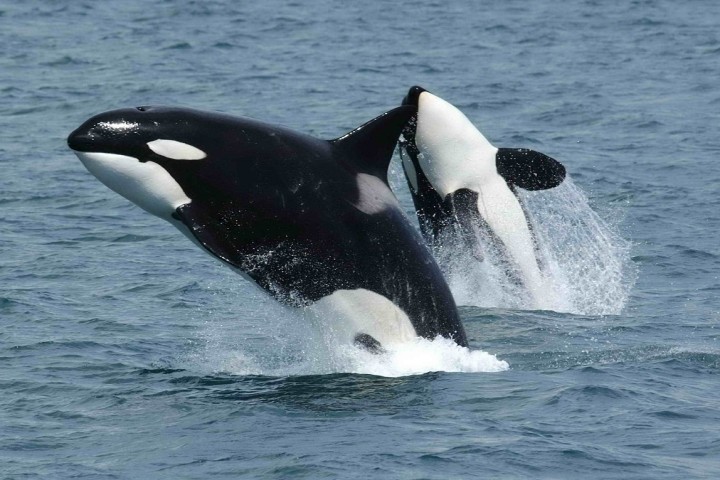Extinction risk to southern resident orcas accelerating as researchers raise alarm

But new research concludes otherwise. Even in the case of one of the world's most charismatic species, the endangered southern resident killer whales that frequent Puget Sound are facing an accelerating risk of extinction, a new population analysis shows.
Despite all we know about them and why they are declining, this beloved species is hurtling toward extinction in plain sight—a peril scientists that published the paper memorably call "Bright Extinction," oblivion happening right before our eyes.
"There is no scenario in which the population is stable," said Williams, co-founder and chief scientist at the research nonprofit Oceans Initiative, and lead author on the paper published in Nature Communications Earth & Environment. "We have a generation or two where the population is not fluctuating around zero, it is fluctuating around a decline, then it accelerates to a faster rate of decline to extinction. That is without all the threats that are worsening. That was a real eye-opener. This is what the status quo will do."
In their model, the scientists found the southern residents declining in population until falling off a cliff in about 50 years—two killer whale generations—with only about 20 of their family members left within a century. Accounting for increasing threats would make the picture even worse.
This, Williams has had to face, is not a problem of adequate information. Instead, it's a matter of inadequate action. "I assumed if only we had the right data we would make the right decisions. But … not only do we know their biology and the threats they face," he said of the southern residents, "we have known these things for a very long time."
Climate change accentuates the extinction risk.
Warming water in the ocean disrupts ocean food webs that feed Chinook salmon—the primary prey of these orcas. And warming rivers hurt salmon survival and reproduction. Other threats, including ocean shipping traffic and other noise that disrupts orca hunting, and habitat destruction also are intensifying. Alteration of the environment is making it, at this rate, a place in which these co-evolved animals can no longer live.
Carl Safina, study author, ecologist and professor for nature and humanity at Stony Brook University in New York, sees in the doom of species extinction and looming loss of the southern residents a moral test for people.
"This is like a slow-motion collision; this is where we see the brick wall or the cliff, it's clear, the road is dry, it's 11 a.m. on a Sunday morning and we are going 8 miles an hour, and it's half a mile away, and then a quarter of a mile away and then we see it, and our smart sensors start beeping, and then we hit the accelerator and crash … why do we do that?"
Laws alone clearly are not enough: The Endangered Species Act, which turned 50 this year, calls for preservation of all species, no matter how humble. Yet here is one of the most intelligent animals in all the oceans, and its top predator, barely hanging on.
What's needed, Safina said, is a fundamental shift in how we all live here.
"Socially, we need an ethic that values the life on this planet, and that sees us as stewards."
So dire is the state of the southern residents—there are only 74 left—that it may be time to consider more drastic interventions, including preventive vaccination of at least some of the most biologically valuable members, the papers' authors state. A plan also needs to be mustered to be ready for a catastrophic event, such as a disease outbreak requiring a veterinary response across the U.S.-Canada border.
To give the southern residents a better chance at hunting success, the paper recommends some profound changes. Voluntary slowdowns already in place for ships have been found to cut noise levels by nearly half, according to the paper, which in turn results in increased hunting activity by killer whales.
Yet at the same time, multiple development projects are underway that will increase shipping traffic in the region, with completion of the second TransMountain tar sands oil pipeline terminating at the port of Vancouver, and a major expansion of the shipping terminal at Roberts Bank, the Roberts Bank Terminal 2 project, planned right at the Fraser River delta where orcas hunt.
It may be time to consider mandatory ocean noise budgets, caps or limits to allow killer whales to hunt scarce prey more effectively, the paper found.
A fresh look at fisheries management also is needed, according to the paper, to leave more fish in the sea for orcas. Moving fisheries in Alaska and British Columbia away from Chinook rearing grounds and migration routes in the sea to river mouth and estuarine locations would result in an immediate increase of Chinook critical to orcas of up to 25%, according to the paper.
Such a fishery could also help recover a Chinook population more like what orcas evolved with. By not harvesting immature fish in marine fisheries and allowing large females to pass through to spawning grounds, a size increase in the Chinook of up to 40% could occur over a 50-year period, according to the paper. That would provide more of the big Chinook orcas need and prefer. Freshwater habitat restoration could also continue to support wild Chinook abundance, instead of releasing more hatchery fish into the sea.
Hatchery fish compete with wild fish for food and spawning area. They also can weaken wild Chinook fitness by interbreeding or disease, noted study author Misty MacDuffee, salmon biologist with the Raincoast Conservation Foundation, a science nonprofit. She sees no pathway to orca recovery without fisheries reform and other changes to protect the orca's preferred food.
Another recent paper published in the peer-reviewed journal Ecosphere examined the relationship between the availability of prey and southern resident population ups and downs, to investigate how those relationships might have changed over time.
The work confirmed the essential link between the southern residents and their preferred food. "Prey still matters," said Eric Ward, an author on the paper and scientist at the National Oceanic and Atmospheric Administration's Northwest Fisheries Science Center. The paper also found that the northern resident orcas—whose population is increasing—could be affecting the southern residents' survival because of competition for the same food in shared waters.
Joe Gaydos, science director of the SeaDoc Society, a science research and education nonprofit and author on Nature paper, said the population analysis was a wake-up call as to just how at risk the southern residents are, without a change in course. What he hopes now is that decision-makers and the public will use that information to ramp up efforts to save a species that defines much of the wonder of the region.
"We have done a lot of great stuff for southern residents, and we need to do more," Gaydos said. "It's like when people go to the doctor in their 60s and say, "Should I eat better and stop smoking and drinking and exercise?" and the doctor says, "Yes, and you need to do all of them and you should have done it 20 years ago." That is what this paper is saying.
"We don't have time. We are talking about making some big changes in the next couple of generations of killer whales, or we are out of time."
That does not make this new work documenting the southern residents' accelerating extinction risk a give-up-hope paper, Gaydos said, but the opposite.
"Now is the time to show the money, and to make the effort." For one thing, we owe it to these animals, Gaydos noted.
The southern residents are in such deep trouble in part because of the capture era, during which a third of the whales were taken for sale to aquariums and other entertainment venues.
"We just need to do what we need to do, make it happen, it is on us, we got them here. We are the reason they are endangered," Gaydos said of the southern residents. "First with the captures, and later with the salmon, and the contaminants we made; those are not naturally occurring, and those are our boats out there."
Tim Regan, former executive director of the U.S. Marine Mammal Commission, who is not an author on the paper, says it's not over for the southern residents. "I personally am one that would say it is never too late," Regan said. Other species, from elephant seals to whooping cranes, have made remarkable comebacks, even from dire straits.
The southern residents are the top predator in these waters, and they are symbolic of the wonder of our natural surroundings, and a commitment to other forms of life that we cherish, Regan said.
"They are such a beautiful reminder of the nature of other species. If we don't care about them, I don't know what we would care about.
"You can't be blamed for failing, but you can be blamed for not trying."
Source: phys.org

